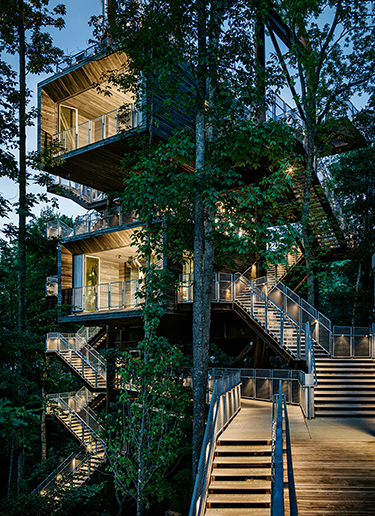|
Subscribe / Renew |
|
|
Contact Us |
|
| ► Subscribe to our Free Weekly Newsletter | |
| home | Welcome, sign in or click here to subscribe. | login |
Architecture & Engineering
| |
November 6, 2013
In 2013, AIA awards favor projects that show how to do more, use less
Special to the Journal
This year the AIA Seattle Honor Awards broke new ground.
The annual event held Monday reflected the spirit of our times, when architects are expected to show how to do more with less space, less money, less resources and even less time.
It was an all-woman jury: Stella Betts of Levenbetts in New York City, Manuelle Gautrand of Manuelle Gautrand Architecture in Paris, and Virginia San Fratello of Rael San Fratello and Emerging Objects in Oakland.
They favored hard-working public structures over million-dollar cabins.
Top honors went to civic and institutional buildings, including the Cleveland Civic Core designed by LMN Architects, which was praised for its conceptual rigor in carving out strategic voids and linking with its surroundings.
Renovation of the University of Washington Odegaard Undergraduate Library designed by The Miller Hull Partnership was honored for being bold by removing a featured stairway to create openness and visual connections. The jury emphasized how both projects did more with less.
The panel also gave an honor award to the Sustainability Treehouse designed by Mithun. It is actually an education project. A subtle feat of engineering allowed the team to meld building platforms with tall trees.
Among the honor awards there was also a small, inhabitable Garage designed by Graypants. The structure of the island retreat is so completely exposed that the building is transparent.
Smallest of all was Octahedron designed by Frankenstein Inc. with LMN. The almost infinitely re-doable pavilion-like structure is made from pre-fabricated pieces and also got an honor award.
Efficient and evocative
| More online |
|
For a complete list of the winners and photos, click here.
|
This year's program seemed to be based on the assumption that no matter what the building use or type, the scale of construction would be the starting point for judging. Built projects were put into three categories, according to size and construction cost.
The word “emotion” was used liberally by the jury to describe the winners. Projects had to evoke good feelings, not just impress with their environmental performance. Small budgets also seemed to count — a lot.
In the merit award category were the usual collection of out-of-the-way vacation places, high in concept and low in square footage. Among them is a pair of modest bridge-like structures projecting from a wine-country riverbank: River Structures designed by Paul Hirzel.
Canyon Barn designed by MW/Works Architecture + Design is just that: a re-imagined and rebuilt barn. One house, Kicking Horse Residence designed by Bohlin Cywinski Jackson, was proclaimed as likely costing the most per square foot, but the jury praised it for sleeping the largest number of people.
Only one urban housing structure made it into the awards circle: Pike Station designed by atelierjones. It got a merit award and accolades for its livability and expression of environmental values.
Two very unconventional projects with almost zero construction cost got top honors. In addition to The Octahedron, Olson Kundig Architects' [storefront] won merit awards. The Olson Kundig project is a concept for changing the use of empty or marginal urban spaces, starting in Pioneer Square.
Lower-tier winners got lots of bang for the buck. ShoWare Center, a civic arena in Kent designed by LMN Architects, got an honorable mention for combining high excitement with simple, low-cost strategies like mirrored overhangs.
On the poetic side, Thresholds, designed by Frances Nelson & Bradly Gunn, is a lacey, lightweight landscape structure in a cemetery — also in Kent — got an honorable mention, as did the multi-layered Technology Access Center designed by The Miller Hull Partnership.
(Editor's note: This story has been changed to correct the spelling of Frances Nelson).
“We had a feeling that this project was made with a very low budget,” said one jury member.
This year's awards also reflect a trend toward recognizing projects that are not habitable buildings.
The conceptual category keeps rising in importance. It was introduced a few years ago to reward good ideas that don't have funding or clients for construction. This year South Park Food Bridge, a piece of “floating micro-infrastructure” designed by David Dahl & Nicole Tsen Lew, won in this category.
A conversation
Every year, the AIA Seattle awards attract more than 100 submittals, and this year was no exception, despite the weak recovery. The event packs the halls with architects and supporters, and produces a handful of winners but many losers — all subjecting themselves to the agendas of jury members from other cities.
Some architects complain about those agendas, real or imagined. But most participants would probably say it's not about winning or losing. It's really about the conversation.
Jim Cutler, who practices in the Bainbridge Island firm of Cutler Anderson Architects, is one of the Northwest's most celebrated architects. He estimates that he has served on more than 50 juries for local chapters of the American Institute of Architects, including in major cities like New York City, Los Angeles and Pittsburgh.
Proportionally, the awards program in Seattle is huge, Cutler said. He could not attend this year, but his firm submitted a large scale, boldly sustainable project: a renovated tower in Portland.
It got no recognition in Monday's program, but Cutler is happy the crowds keep coming. “Seattle is an architecture town,” he said, proudly.
Clair Enlow can be reached by e-mail at clair@clairenlow.com.



